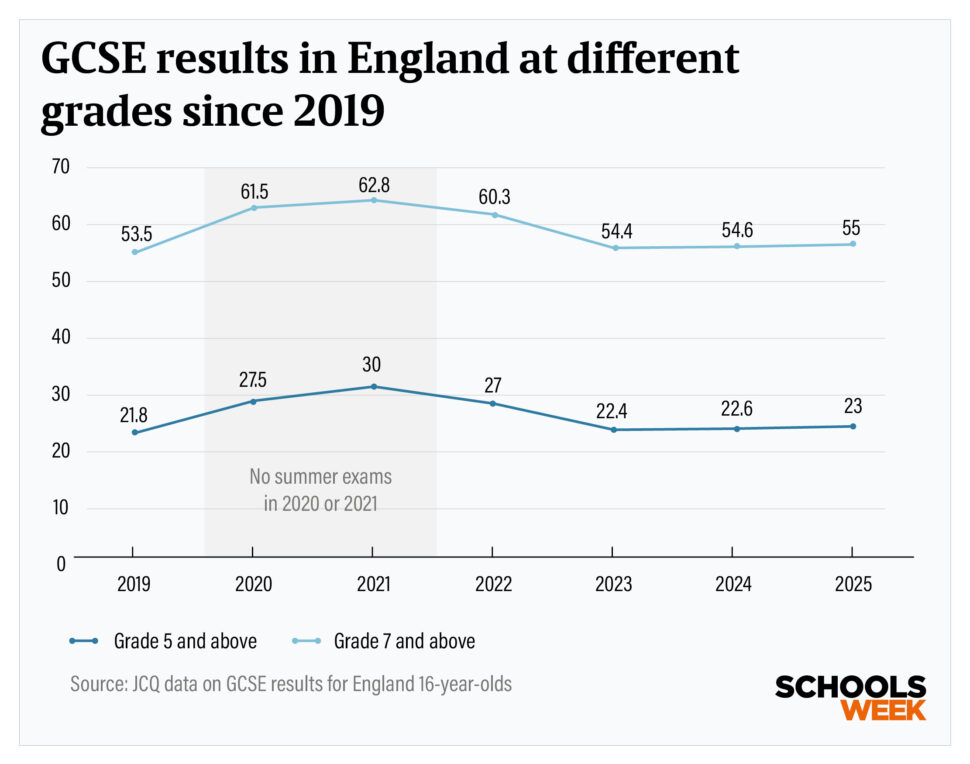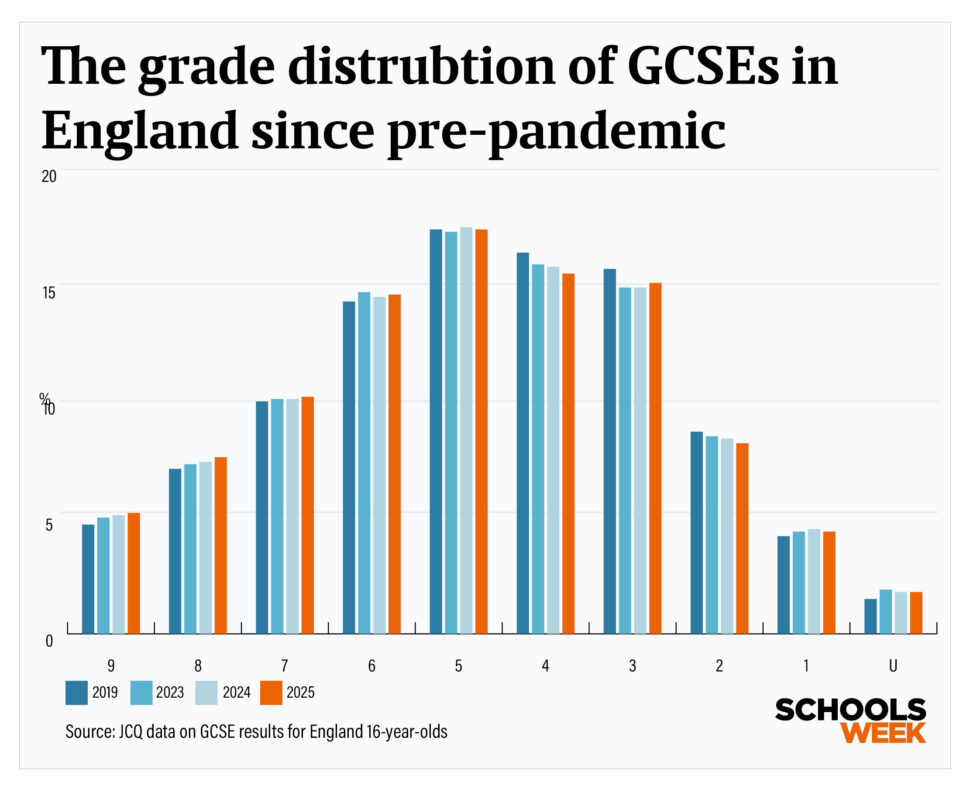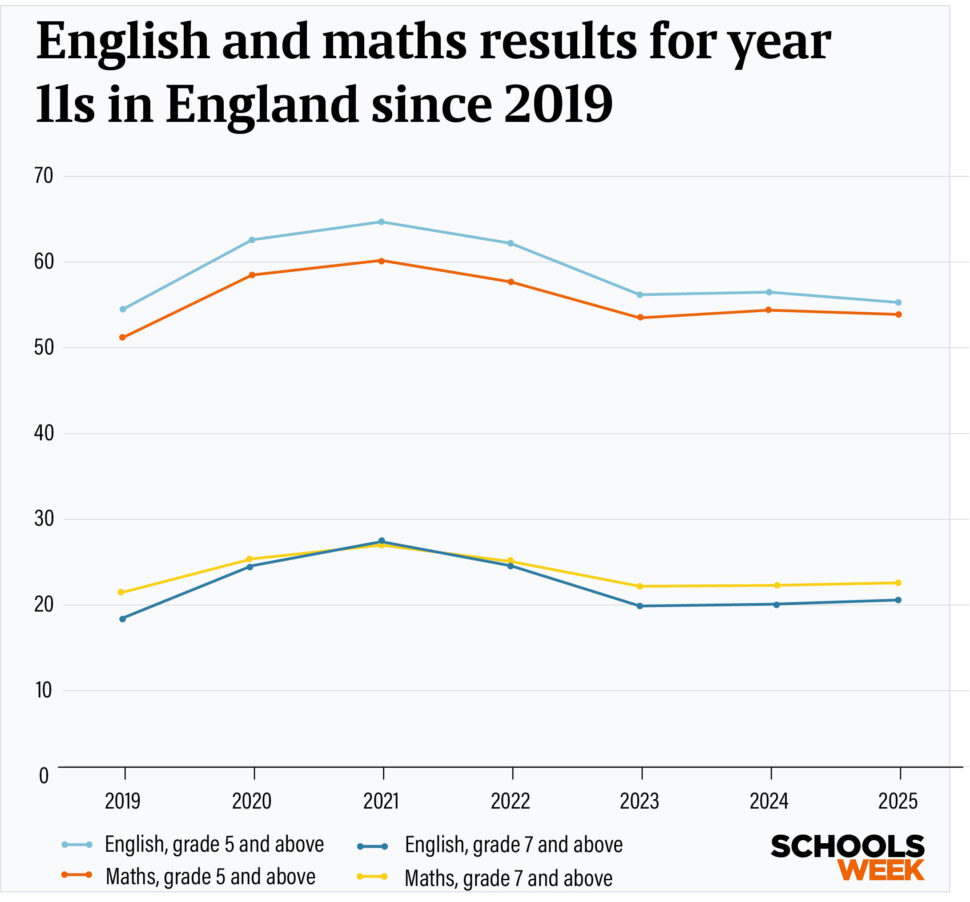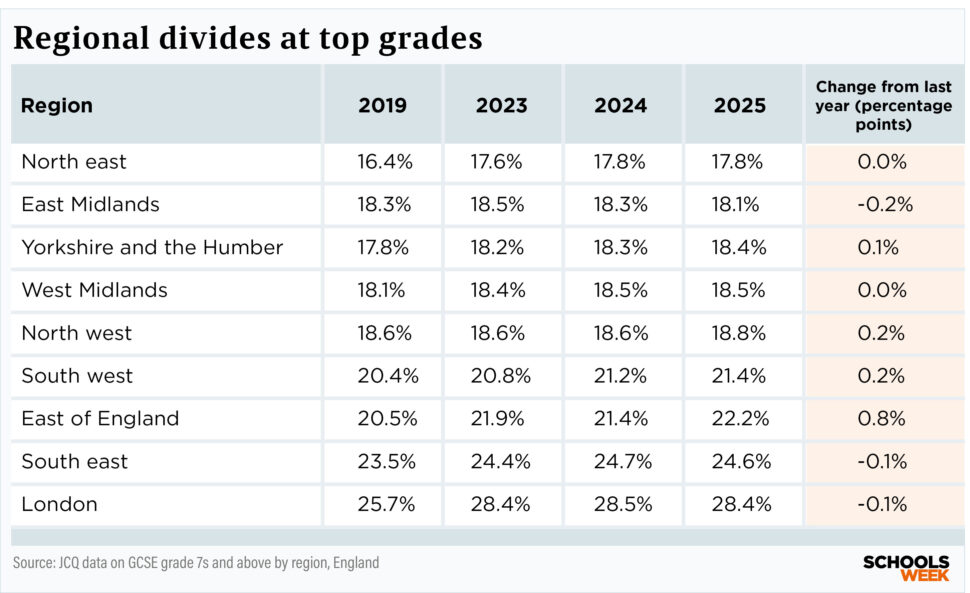GCSE results are out this morning – here’s your handy Schools Week round up of the key trends.
All findings below, unless stated otherwise, are based on the figures for 16-year-olds in England only, which is why they may differ to what you read elsewhere.
1. Grade 5+ pass rate up again
We’ve always highlighted the grade 5 and above pass rate – considered a “strong” pass – because it’s how schools are judged in league tables. Grade 4 is a “standard” pass.
The grade 5-pass rate has risen slightly for the second year in a row from 54.6 per cent last year to 55 per cent. The figure stood at 53.5 per cent in pre-pandemic 2019.
The grade 4-pass rate has again risen marginally. It has edged up from 70.4 per cent to 70.5 per cent. This is compared to 69.9 per cent before the outbreak of Covid.

2. Top grades rise 6% since 2019
The proportion of top grades (7 to 9), which is equivalent to A*/A in old money, has risen by almost 2 per cent this year.
Standing at 23 per cent, the share of grade 7s and above is 5.5 per cent higher than in 2019 (21.8 per cent).
The proportion of 9s has again edged up by 0.1 of a percentage point to 5.2 per cent. This is 10.6 per cent higher than 2019 levels.

3. English and maths passes fall
Top grades in English again rose more than in maths. For English, 19.5 per cent of marks were 7 or above, 2.6 per cent up on last year.
In maths, the increase stood at 1.4 per cent – 21.5 per cent were grade 7 or above compared to 21.2 last year.
Despite this, the grade-5 pass rate fell for both subjects. In English, the figure was 54.2 per cent, down from 55.4 in 2024.
Meanwhile, in maths the proportion dropped from 53.3 per cent to 52.8 per cent.

However, as was seen last year, the proportion of pupils achieving a grade 4 or above in English and maths fell slightly, meaning more face re-taking the qualifications during their post-16 education.
In English, 70.6 per cent of grades were at grade 4 and above, down 0.8 per cent on the 71.2 per cent last year. For maths, the number was 71.9 per cent, down from 72 per cent last year.
But all remained above 2019 results.
4. GCSE entries slip
Entries to GCSEs in England among 16-year-olds fell from 5,214,826 in 2024 to 5,146,724 this year, a decrease of 1.3 per cent.
This was predicted in provisional entries data published by Ofqual earlier this year.
5. Performing arts on the up as sciences and computing fall
Performing arts saw the largest rise in the number of students taking the subject, with a 8 per cent increase between 2024 and 2025. It was followed by Music (6 per cent up).
Statistics (5 per cent), business studies (3 per cent), classical subjects (2 per cent), physical education (2 per cent) and Spanish (2 per cent) also saw increases in the number of pupils.
Engineering saw a 19 per cent fall in the number of entries, while Chemistry, Biology and Physics all witnessed 6 per cent drops.
Computing entries also saw a 5 per cent decrease, while and media/film/TV studies experienced a 3 per cent fall.
6. Grades rise in east as London sees dip
The gap in top grades across all entries between the best- and lowest-attaining regions, the north east and London, narrowed for the second year running, falling by 0.1 percentage points from 10.7 per cent to 10.6 per cent.
Despite this, it’s still wider than pre-pandemic (9.3 percentage points).
London was one of three regions – including the south east and east Midlands – that saw its proportion of top grades fall this year. About 28.4 per cent of grades in the capital were 7 or above, compared to 28.5 per cent last year.

Four witnessed a rise. The largest increase was in the east of England, where the figure jumped by 0.8 percentage points to 22.2 per cent.
7. Gender gap narrows
The gap between girls and boys has narrowed by 12 per cent.
This year, the proportion of 7s and above issued to 16-year-old girls remained the same at 25.5 per cent. But for boys it rose 0.7 percentage points from 19.8 per cent to 20.5 per cent.
The gap now stands at 5 percentage points, down from 5.7 percentage points last year. Prior to the outbreak of Covid, the difference between girls and boys was 6.5 percentage points.
8. How results vary by school type
According to data published by Ofqual today, English grammar schools registered the highest proportion of top grades (63.2 per cent). This has risen by 2.9 percentage points since last year.
However, Ofqual has changed how it records selective schools’ data, which may have contributed to the change.
The figures also show a fall in private schools from 48.4 per cent to 48.1 per cent, which is in line with pre-Covid.
The proportion of top grades in academies, comprehensives and free schools stood at 19.5 per cent, 19.7 per cent and 23.7 per cent respectively.














Trends of intrigue. In a world of social media, popularity of performance arts and music, compared to sciences is not a surprise. Assume easier to pass, may be an elements of schools’ “persuasions”, to boost schools’ appearance, otherwise GCE A(S) chemistry expected to decline in future?